#SEOChanges
Explore tagged Tumblr posts
Text
March 2025 Google Latest Updates: What You Need to Know

As previously mentioned, the last update from Google concerning the algorithm is now live, and it comes with another shift in rankings. The previously covered issues continue to impact an information technology company, a startup, a professional, or a business owner in ensuring that they remain visible online. Here’s a summary of the key updates and their implications for your website. Read More: https://medium.com/@codeologyai/march-2025-google-latest-updates-what-you-need-to-know-e4fc724f721e
#GoogleUpdates#March2025#SEOChanges#GoogleAlgorithm#DigitalMarketing#SEOTips#MarketingTrends#GoogleNews#TechUpdates#SearchEngineOptimization
0 notes
Text
Mastering Google Algorithm Updates: Navigating SEO Changes for Success in 2024
Stay ahead in the digital landscape with insights from Matrix Bricks on mastering Google algorithm updates. Learn how businesses can maintain visibility and relevance by adapting to changes in Google's search algorithms. This comprehensive guide covers the importance of quality content, mobile-friendliness, user experience, and the E-A-T framework. Understand the significance of high-quality backlinks and strategic adaptation to algorithm updates. Enhance your SEO strategy and secure long-term success by prioritizing valuable content, seamless mobile experiences, and a trustworthy online presence.
Click here to read the full article and stay ahead in the ever-evolving landscape of digital marketing: https://bit.ly/3sMbdvL
Connect with us on:
Official Website: https://www.matrixbricks.com/in/
Facebook: https://www.facebook.com/MatrixBricks
Twitter: https://x.com/MatrixBricks
Instagram: https://www.instagram.com/matrixbricksinfotech/
LinkedIn: https://in.linkedin.com/company/matrix-bricks-infotech
YouTube: https://www.youtube.com/@Matrixbricks
#GoogleAlgorithmUpdates#SEOChanges#SearchEngineOptimization#SEO2024#DigitalMarketing#AlgorithmicShifts#SEOStrategy
0 notes
Text
Google's March 2024 Core Algorithm Update: Everything You Need to Know

Ready to dominate search results after the Google March 2024 Algorithm Update shakeup? 📈🔍
The March 2024 Core Update is here, and it's all about weeding out low-quality content. 🌱 That means HUGE opportunities for sites with valuable, user-focused content! 🌟
In this post, we break down the update's impact and give you actionable tips for success:
Slashing Unhelpful Content: Google aims to reduce low-quality content by a whopping 45%! ✂️
Targeting Content Abuse: From mass-produced articles to shady domain tactics, Google's cracking down. 🛡️
Winning Strategies: Focus on high-quality, original content & prioritize user experience! 🏆
Plus, we answer all your burning questions about the update! 🔥
Ready to learn more? Check out the full blog post: https://www.linkedin.com/pulse/googles-march-2024-core-algorithm-update-everything-qx3lc/
#SEO#GoogleUpdate#ContentMarketing#March2024CoreUpdate#GoogleAlgoUpdate#SEOChanges#ContentQuality#UserExperience#SEOTips
0 notes
Text
ꕥ who do you want to read about ✧˖°.🎧˖°. 📖

ꕥ 𝒷𝒶𝓃𝑔 𝒸𝒽𝒶𝓃
~ born 3rd october 1997, Christopher chahn bahng grew up in australia but was born in seoul. leader of stray kids, part of the sub unit 3racha (cb97) and produces songs for stray kids.
ꕥ 𝓁𝑒𝑒 𝓂𝒾𝓃𝒽𝑜
~ born 25th october 1998, lee minho or better known as lee know was born in daegot-myeon, gimpo-si, south korea. he is part of the sub unit danceracha in stray kids.
ꕥ 𝓈𝑒𝑜 𝒸𝒽𝒶𝓃𝑔𝒷𝒾𝓃
~ born 11th august 1999, seo changbin was born in yongin-si, south korea. he is part of the sub unit 3racha (spearb) and produces songs for stray kids.
ꕥ 𝒽𝓌𝒶𝓃𝑔 𝒽𝓎𝓊𝓃𝒿𝒾𝓃
~ born 20th march 2000, hwang hyunjin born in seongnae-dong, seoul, south korea. he is part of the sub unit danceracha in stray kids. also known as the visual of the group.
ꕥ 𝒽𝒶𝓃 𝒿𝒾𝓈𝓊𝓃𝑔
~ born 14th september 2000, han jisung born in seochang 2-dong, south korea. he is part of the sub unit 3racha (j.one) and produces songs for stray kids.
ꕥ 𝓁𝑒𝑒 𝒻𝑒𝓁𝒾𝓍
~ born 15th September 2000, felix yongbok lee born in seven hills, australia. he is part of the sub unit dance racha and known for his deep voice and freckles.
ꕥ 𝓀𝒾𝓂 𝓈𝑒𝓊𝓃𝑔𝓂𝒾𝓃
~ born 22nd september 2000, kim seungmin born in samseong-dong, seoul, south korea. he is part of the sub unit vocalracha and known as the menace of the group.
ꕥ 𝓎𝒶𝓃𝑔 𝒿𝑒𝑜𝓃𝑔𝒾𝓃
~ born 8th february 2001, yang jeongin or better known as i.n was born in sujeong-dong, busan, south korea. he is part of the sub unit vocalracha and is the makne of the group.
⋆ ˚。⋆୨୧˚☁️🌱♡‧₊˚
©hazerachas-blog 2025
#hazeracha#stray kids#bang chan#lee know#seo changbin#hwang hyunjin#han jisung#lee felix#kim seungmin#yang jeongin#stray kids masterlist#skz#skz masterlist
36 notes
·
View notes
Text
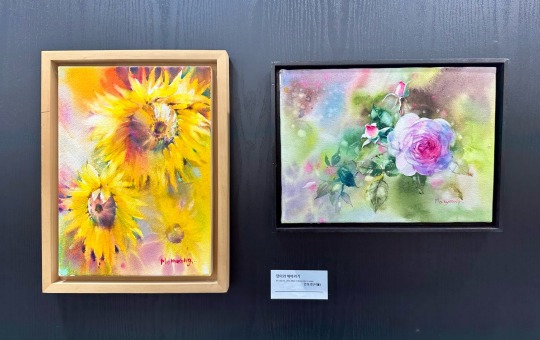
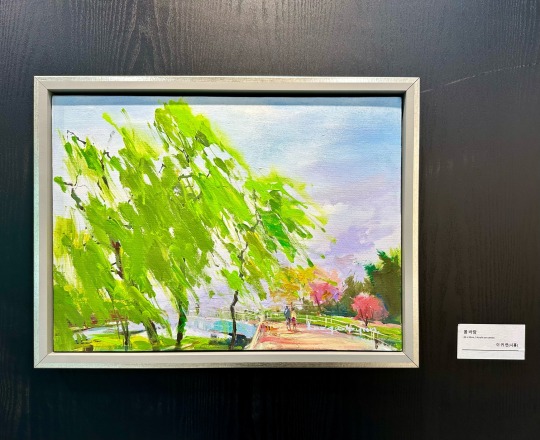
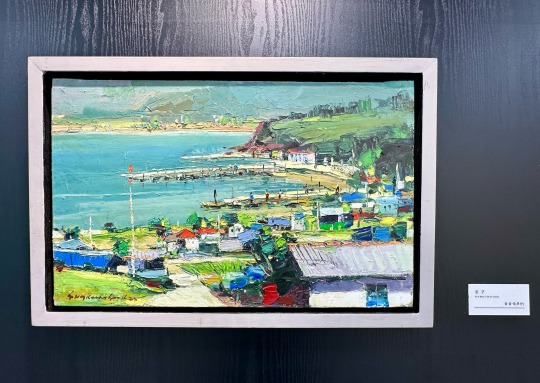
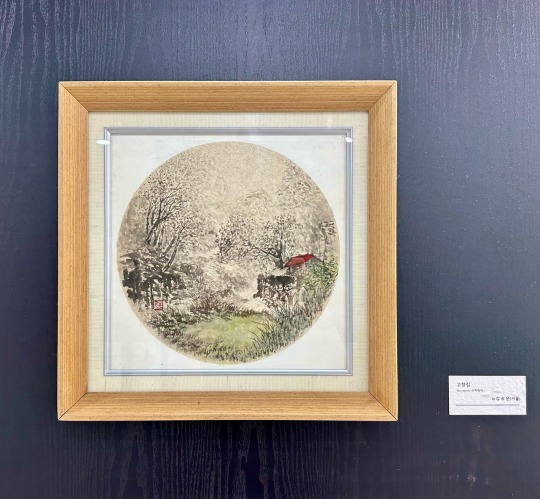
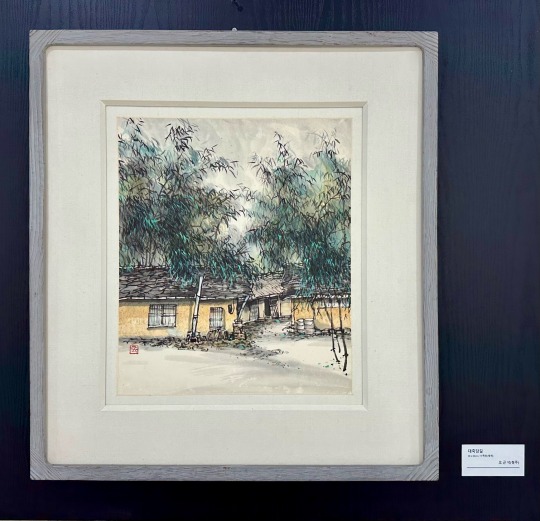
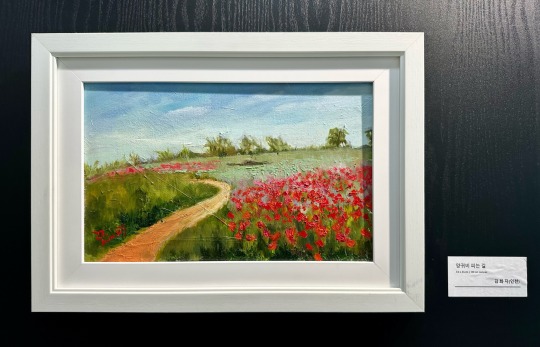
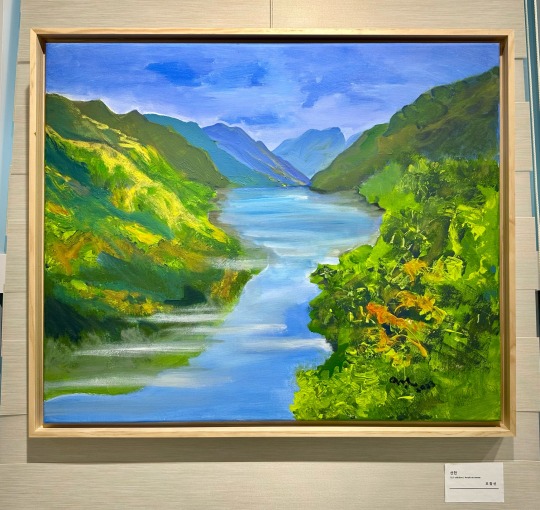
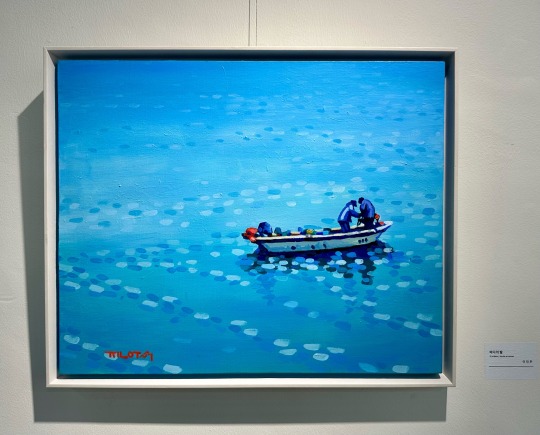
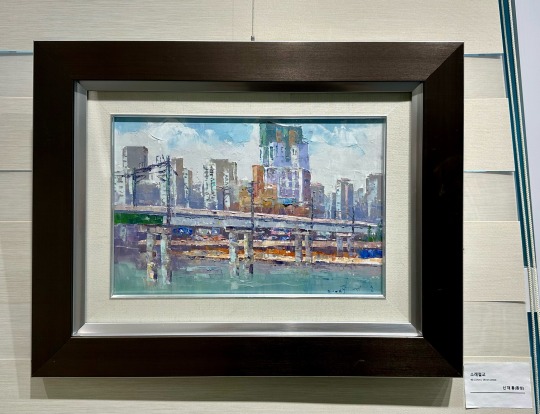
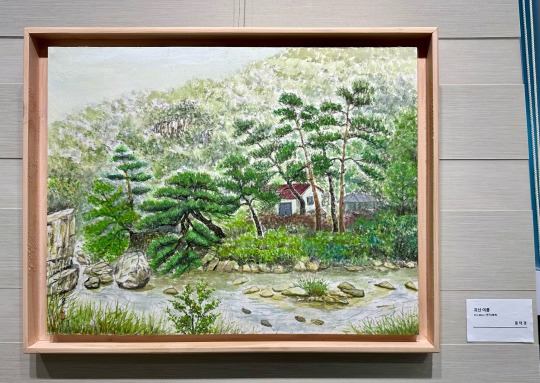
Went to Seochang Eoul Madang!
Seochang Eoul Madang is a multi-generational complex consisting of a sports center, a living culture center, a small library, a healthy living support center, and a dementia care center. It is a space for learning and sharing to help local residents live a healthy life and realize abundant cultural welfare.
0 notes
Photo










I wonder how His Highness is. I mean, he’s got Seo-bi hanging around him, so I’m sure he’s well.
#kingdom#킹덤#bae doona#ju jihoon#배두나#주지훈#lee chang x seobi#maybe i'm obsessed with their dynamic#even if we don't see that much of it#the fact that they lived together for 7 YEARS.....hello#i'm in seochang overdrive#mine#spoilers#seobi#lee chang
230 notes
·
View notes
Photo
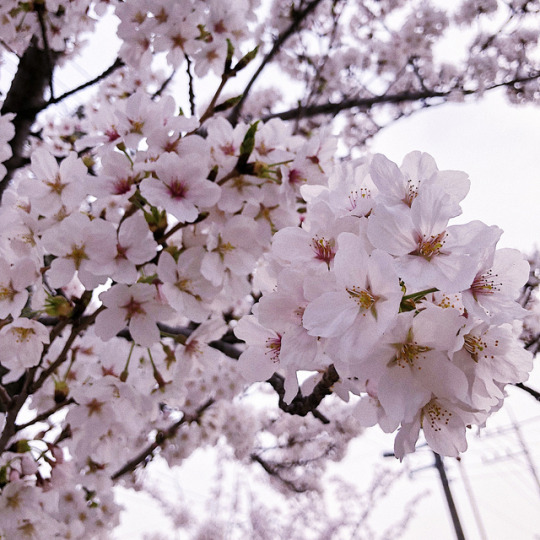
Ohhhh😍😍😍 #cherryblossom #cherry #spring #inspiration #SouthKorea #Yangsan #Seochang (at Yangsan)
9 notes
·
View notes
Text
ink.
character introduction (part zero)
a fifteen part SocialMedia!AU featuring Bang Chan of Stray Kids. started: august 18th, 2019 completed: august 27th, 2019
lower-case intended.

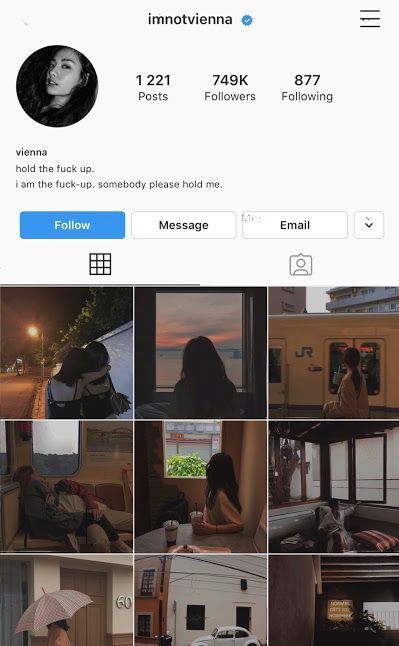
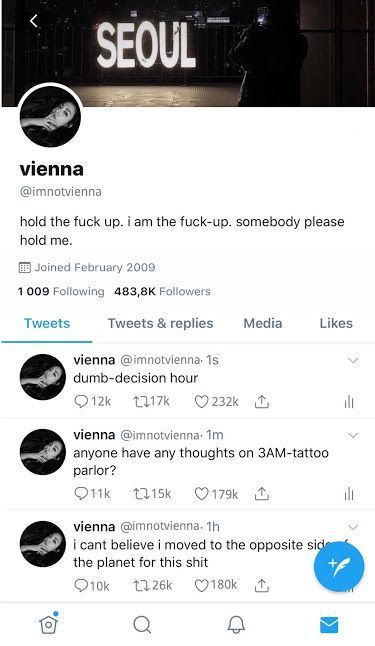
name: vienna ahn. nationality: korean-american. born and raised in america. year of birth: 1998.
@imnotvienna



name: bang chan. nationality: korean-australian. year of birth: 1997.
@bangtattoo



name: hwang hyunjin. nationality: korean. year of birth: 2000.
@hyvnjin



name: han jisung. nationality: korean. year of birth: 2000.
@jisvng

+
name: seo changbin. nationality: korean. year of birth: 1999.
@seochang
&
name: kim woojin. nationality: korean. year of birth: 1997.
@carebearjin

part zero
part one
part two
part three
part four
part five
part six
part seven
part eight
part nine
part ten
part eleven
part twelve
part thirteen
part fourteen
part fifteen

-bentley
#kpop#stray kids#skz#bang chan#hwang hyunjin#han jisung#social media#bang chan au#stray kids scenarios#stray kids reactions#stray kids requests#stray kids one shots
36 notes
·
View notes
Text
Park Jiwon

Nombre Artístico: Jiwon (지원)
Nombre: Park Ji Won (박지원)
Nombre Inglés: Megan Park
Posición: Main Vocal
Fecha de Nacimiento: 20 de Marzo de 1998
Signo Zodiacal: Piscis
Estatura: 158 cm (5’2″)
Peso: 49 kg (108 lbs)
Grupo Sanguineo: A
Lema: “Ten valor y se amable.”
DATOS CURIOSOS
– Apodos: Megan, Kkomaengie.
– Colores favoritos: Purpura, Colores brillantes, Negro.
– Hobbies: Escuchar música e ir de shopping.
– Es muy buena en los juegos y actividades deportivas.
– Jiwon es originaria de Busan, Corea del Sur.
– Ella acudió a Chungdam Senior high school.
– Jiwon es Zurda (es la única del grupo que lo es).
– Jiwon es buena rapeando.
– Jiwon tiene el habito de mover las cejas.
– Jiwon tiene la voz más fuerte/ruidosa en Fromis_9.
– Ella es fan del Gaming e imitaba personajes de Overwatch cuando estuvo en Idol School.
– Su habito al dormir es que lo hace siempre con la boca abierta.
– Jiwon ha dicho que su rol modelo es su Padre.
– Jiwon piensa que su punto más encantador es su hoyuelo.
– Jiwon le encantan los filmes de terror.
– Jiwon también le encantan los Simpsons.
– Sus comidas favoritas son el Queso y el sushi. Sus postres favoritos son los chocolates.
– A ella no le gusta el helado ni el chocolate con sabor menta.
– Sus animales favoritos son los perros grandes. En especial los Golden Retrievers.
– Tanto ella como Chaeyoung tienen miedo de las palomas y los pájaros.
– No le gusta que le digan Han Ji-min(actriz coreana con quien tiene cierto parecido físico).
– Cuando Jiwon era mas joven, fue a un centro de patinaje sobre hielo y aprendió patinaje artístico, según un informe de un fan en el tercer fan meeting. También aprendió a montar a caballo.
- Jiwon solía ser tranquila y callada, pero se hizo más sociable después de tomar lecciones de música.
– Jiwon es una antigua aprendiz de JYP, entreno con ellos por 4 años y 9 meses. Ahí conoció y paso el tiempo con su actual compañera de fromis_9 Chaeyoung.
– Jiwon apareció como un cameo en el video oficial de Miss A’s “Only You”.
– Jiwon fue participante en Sixteen (El Survival Program que dio forma al grupo TWICE). Y piensa que su experiencia en SIXTEEN la ayudó a aprender mucho(renuncio a JYP cuando perdió en este reality).
– Jiwon termino en 6º lugar en Idol School con 63,816 votes, gracias a eso fue integrada al Grupo Fromis_9.
– Hayoung, Chaeyoung y ella comparten habitación – “Bbiyoongz Room”, porque es la habitación más ruidosa del dormitorio de Fromis_9.
– Hayoung y ella tienen un equipo de composición musical llamado “Dam-Dam” (Fm-1.24 fromis_9 Official Youtube)
– Además de las integrantes de TWICE, ella es cercana a (G)I-DLE‘s Miyeon y IZ*ONE‘s Chaeyeon.
- Dentro del grupo comparte el mismo año de Nacimiento y Edad con Jisun.
– Sus cantantes favoritos son IU, Rihanna, Ariana Grande y DPR LIVE.
– El tío de Jiwon era dueño de una cafetería en Seochang-dong, Yangsan-si, Gyeongsangnam-do, Corea del Sur. Cuando acudes a la cafetería, puedes ver fotos de apoyo de sus fans.
– El tipo ideal de Jiwon: Alguien Mayor, quien la haga sentir segura, el ejemplo que dio fue el actor “Ma Dong-seok”.
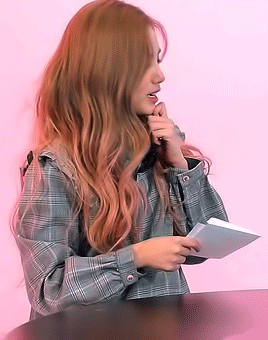
1 note
·
View note
Text
Sistema de prostitución en Europa Occidental ♧/[BCGAME5.COM] # Video de prostitución en América del Norte
Verificación de casas en Europa Occidental ™/[BCGAME5.COM] Sitio de prostitución comunitario Chad en Marina Bay Adultos en Europa Occidental [Tele @JBOX7] Localización de casas en Honduras Acceso a las casas en Europa Occidental Mapa de Casas en Uchang en Uchang] [Versión Europea de Casas en UBOXkChchang en Uchangchang en Uchang en Uchang en Ukchang] Videochang]Pueblo Chats Abiertos Europa Occidental Bloqueo [Consulta la sede de Toto] Ciudad de Buró de Etiopía Último Lugar de Prostitución Argentina [Comprando la placa de tierra] Ciudad de Buró de Hungría Último Domicilio [Cazipán Turco] Ciudad de Shipping de Seochang de Kakaochang de Kakaochang de Kakaokiyama] Ciudadchang de la Ciudadkuk.
0 notes
Text
Seo Jisoo & Choi Sungyoon
Likesinho e se pegar algum por favor me avise.
Seo Jisoo:
@\jisoowae
@\jisoohome
@\jisooleft
@\seohurt
@\seoocean
@\seochange
Choi Sungyoon:
@\sungyoonwhy
@\sungyoonlove
@\sungyooncute
@\sungyoonsoft
@\sungyoonwin
@\sungyoonsea
#seo jisoo#choi sungyoon#lovelyz#golden child#users#seo jisoo users#choi sungyoon users#lovelyz users#golden child users#kpop#kpop users#kpop bios#kpop icons#seo jisoo icons#choi sungyoon icons#lovelyz icons#golden child icons#beh#rq
3 notes
·
View notes
Text
Nampō Roku, Book 4 (21.2): Displaying the Kakemono [掛物], Part 2.

3) Displaying two scrolls at the same time¹.
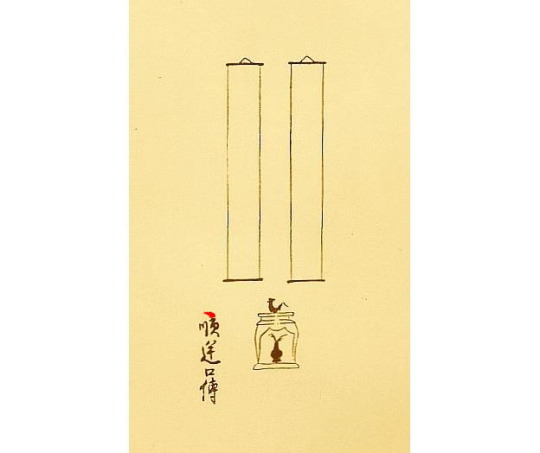
[The writing reads: jun-gyaku ku-den (順逆口傳)².]
4) When hanging one scroll by itself³.
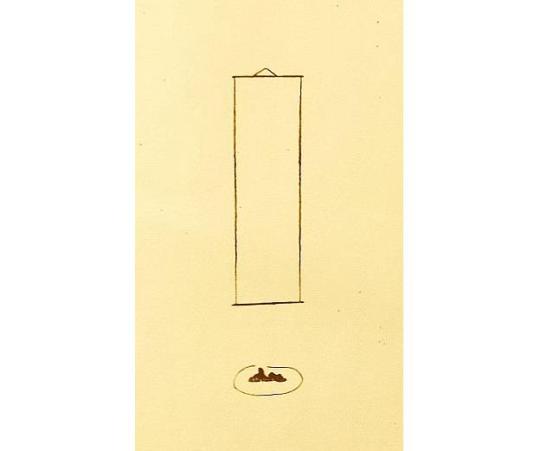
_________________________
¹Ni-haba ittsui [二幅一對].
“Two widths [displayed] as a unit.”
As discussed in the previous post, haba [幅], which literally means “width,” is the counting word for scrolls (and also bolts of cloth -- which were rolled up around a dowel in a similar manner).
²Jun-gyaku ku-den [順逆口傳].
“The way to arrange [these things] in the jun [順] and gyaku [逆] [settings] is something that should be transmitted orally.”
This note refers specifically to the kōro* (shaped like a bird) that is shown in the drawing -- which may have been inspired by the kamo-kōro [鴨香爐] shown below†, that was one of Yoshimasa’s treasures -- as well as other objects that can be said to face in a certain direction.
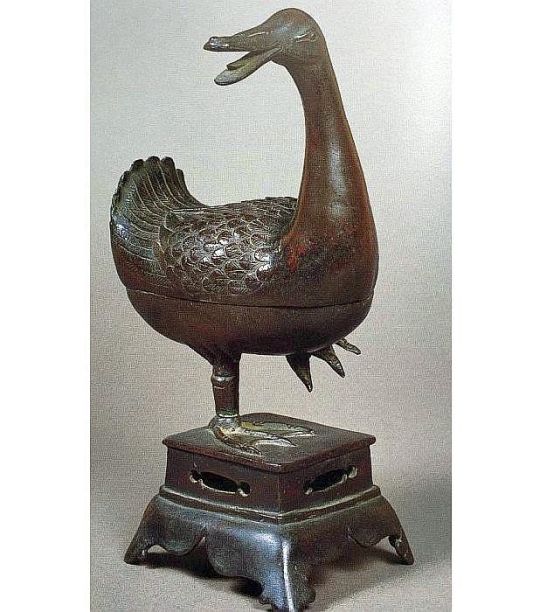
This, Tanaka Senshō points out, refers to the same set of arguments that were articulated in the previous installment, with respect to the way to orient the kame-tsuru shoku-dai [龜鶴燭臺] (a candlestick shaped like a crane standing on the back of a turtle) when it was displayed as part of a mitsu gu-soku: “in a toko that opens toward the south” (i.e., one where the toko-bashira is on the left), “the bird’s left eye should be seen” (that is, the bird should seem to be looking toward the toko-bashira), as in the above photograph. “In a toko that opens toward the north” (the toko-bashira is on the right; and the toko is located on the guest’s left), “the right eye of the bird (or other animal) should be to the front.” ___________ *It can also be understood to refer to the scrolls as well, though in the reverse manner -- since the orientation of the scrolls (whether the subject faced to the left, the right, or straight forward) determined the orientation of the tokonoma in which they were to be hung.
Whether sets of several scrolls (at least those intended to constitute a set by the original artist), or a single composition, the toko-bashira was supposed to be located on the side where the artist’s colophon, signature, and name-seals were found. This was so that an oil-lamp could be suspended from a hook temporarily nailed into the toko-bashira to illuminate the name (this was because the original pieces displayed in the toko were created by renowned monk-artists, and so the works were considered to be their “shadow;” thus the name was important as the focus of the viewer’s reverence, and so more “important” than the painting itself).
Thus, the toko was only designed after the painting came into the host’s hands -- and it was not unknown for people to change the orientation of their rooms appropriately when they came into possession of a new and important scroll. (It is important to note that this was not simply a sixteenth century idea: the construction of Yoshimasa’s residential palace appears to have been undertaken only after the dōbō-shū concluded their inventory of the shōgunal storehouses, and selected the collection of pieces of art that would thenceforth be displayed in the various shoin of that complex -- some mounted as scrolls, and some, due to partial deterioration, used to paper the sliding doors and panels in the various rooms.)
†This shows how distortions can creep in -- when the people responsible for creating the sketch have never seen the original object that is being depicted.
——————————————–———-—————————————————
3) Displaying two scrolls at the same time.
Here, Tanaka Senshō quotes the ku-den (as it was articulated by the Enkaku-ji scholars): “[In the case where two scrolls are hung at the same time,] you must understand that the space between [the scrolls] should be two-thirds of what is found on the left and right*. The kane-wari remains the same irrespective of the largeness or smallness [of either the scrolls or the tokonoma]†.
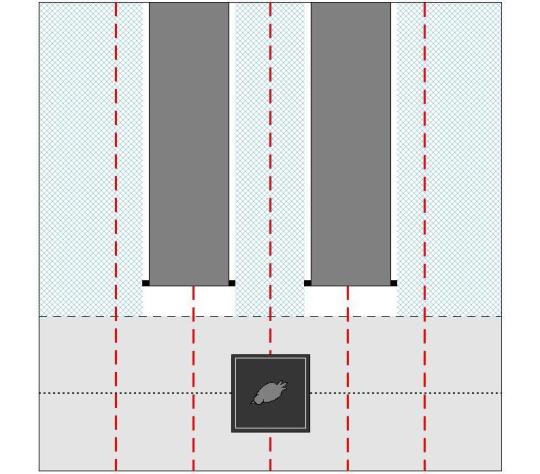
“[However] when two go-motsu [scrolls] that are unequal [are displayed at the same time], then one must consider this very carefully before deciding [what to do]‡.
“When two scrolls are hung at the same time, however, there are no other special considerations, but [you] must know that the kane correspond to the size of the toko**. This [point] must be understood very carefully, because [you] must understand that the same always applies when even a single scroll [is being displayed]††.”
As for the oki-mono, it should be arranged on the central kane. The reason is because the flowers and censer, placed [together] on a joku, should be located in the space between the scrolls‡‡. ___________ *Naka no aki-ma hidari-migi no san-bun-no-ni to kokoro-e-beshi [中のあき間左右の三分二と心得べし].
Aki-ma [空き間] refers to the “empty space” between the scrolls.
San-bun-no-ni [三分二], “two parts of three” -- two-thirds.
†Dai-shō tomo ni onaji kane-wari nari [大小共に同じ曲尺割なり].
Here, dai-shō tomo ni [大小共に], “largeness or smallness,” could refer either to the size of the tokonoma, or to the size of the scrolls -- and, most likely, both of these meanings were intended.
‡Go-motsu mu-jun no ni-zon ni te kiwameraruru to iu-iu [御物無準の二尊にて極めらるゝと云々].
Go-motsu [御物] refers to scrolls that came from Ashikaga Yoshimasa’s Higashiyama collection.
Mu-jun [無準] means unequal, not equal (to each other). This allows for several possible interpretations:
- While both scrolls came from Yoshimasa’s collection, within his collection the scrolls were segregated into those of the highest quality, those of average quality, and those of inferior quality (or questionable provenance) by the dōbō-shū. Therefore, if a scroll of the highest quality was being displayed simultaneously with one of a lesser quality....
- However, this could also refer to the case where scrolls of equal quality would be ranked according to their subject matter. For example, an image of Kannon, paired with a second scroll that depicted a natural scene or landscape.
Ni-zon ni te [二尊にて]. Ni-zon can mean two images of the Buddha (or of his Buddha-forms). However, it can also refer specifically to an image of the Gautama Buddha, Siddhārtha (Shakamuni-butsu [釋迦牟尼佛]) and an image of the Buddha Amitābha (Amida-butsu [阿彌陀佛]). In this case, Shakamuni would probably be considered “superior” to Amidaᵃ.
No direction is given by the scholars. Only that the host must consider very, very carefully before deciding what he will do: perhaps the two paintings will be displayed side by side, as explained here, or perhaps one will be displayed in the middle with the other off to one sideᵇ. ___________ ᵃThe ancient Amida temple in what is now the Seochang valley between Pusan and Ulsan featured a small mountain in the middle, which was shaped like the dying Shakumuni. The rolling hills to the east were likened to his human followers, while the high cliff to the west, which leans toward the valley at the top was likened to Amida bowing his head in homage to the Buddha as he entered into nirvana. This scene offers the precedent for this interpretation. (Chanoyu appears to have entered Japan from that temple, which was destroyed during the early Joseon period.)
ᵇAnd if they are arranged equally, which one will be on the left (the side closest to the toko-bashira, which is the higher position within the tokonoma), and which one will be hung on the right?
If both portraits are looking to one side, then they should be arranged so that both look toward the center of the toko. If one is looking forward, while the other is looking off to one side, perhaps the one looking forward should be hung on the left, while the other looks toward the center of the toko. But, again, it is not possible to set these things down as rules, and the host must consider very carefully before he hangs them up.
**Kane wo kokoro-eru koto toko no dai-shō sō-ō ari [曲尺を心得る事床の大小相應あり].
The kane -- in other words, the spacing of the five kane -- are determined by the width of the toko. Nothing else determines their locations. This is why this idea is repeated twice in the ku-den.
††Ichi-haba-butsu izure mo kono kokoro-e nari [一幅物何れも此心得なり].
Ichi-haba-butsu [一幅物] means a scroll that should always be displayed by itself.
Izure mo [何れも] means “in every case;” “under any circumstances;” “always.”
In other words, when a single scroll is being hung by itself, it should be hung in the center of the toko. And the center (and all of the other kane) is determined by the dimensions of the tokonoma itself.
‡‡Kakemono no ake-ma ni hana to kōro to ga joku ni yotte okarete iru-koto ni chū-i-subeki de aru [掛物の空け間に花と香炉とが卓によって置かれて居ることに注意すべきである].
In general, the things stood on the floor of the tokonoma should be located in the spaces between the scrolls -- especially if they are high enough to obscure the lower part of the scrolls (as are the things placed on the joku).
——————————————–———-—————————————————
³Ichi-haba no toki [一幅の時].
“When one width [is displayed by itself].”
——————————————–———-—————————————————
4) Displaying one scroll.
Here, the scroll (whether narrow or wide) is simply hung from a hook attached in the center of the toko, with the oki-mono -- a bon-san [盆山] -- placed directly in front of it*.
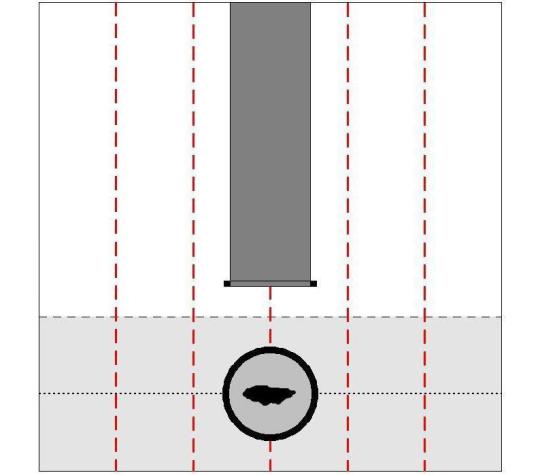
Notice that, in the early period, bon-san were usually displayed on round trays‡. The oblong appearance in the sketch from Book Four may simply have been intended to represent perspective -- though, beginning in the Edo period, oval trays started to appear (perhaps the result of taking sketches such as this literally), and remain the mainstay even today. ___________ *The ku-den includes the assertion sukoshi demo jiku wo mi-kiru-koto wa kinmotsu to shite aru [少しでも軸を見切ることは禁物としてある], which means “it is forbidden to obscure the scroll, even by a little.” This is the rule that has been handed down since ancient times, regarding the oki-mono; and it is the reason that it was said (in the previous entries) that the oki-mono should be located in the spaces between the scrolls.
While the idea of placing the bon-san in the center of the tokonoma might appear to contradict this pronouncement, it is important to note that there was always an exception to this rule -- and it is possible that showing the oki-mono as a bon-san was done deliberately, as a way to illustrate this exception.
To summarize Tanaka Senshō’s explanation of this important caveat: if the thing that is displayed in front of the scroll(s) is low enough that it will not hide any part of the scroll, then it is permissible for it to be displayed in front. Thus, the naga-joku, bearing the mitsu gu-soku, could be arranged in front of the three scrolls -- but only when the table was low enough that the things arranged on it did not hide the lower part of the middle scroll, as is clear in the sketch from Sōami’s O-kazari Ki [御飾記], below. (Tanaka adds that there is also another exception, which will be covered under the discussion of a subsequent illustration.)
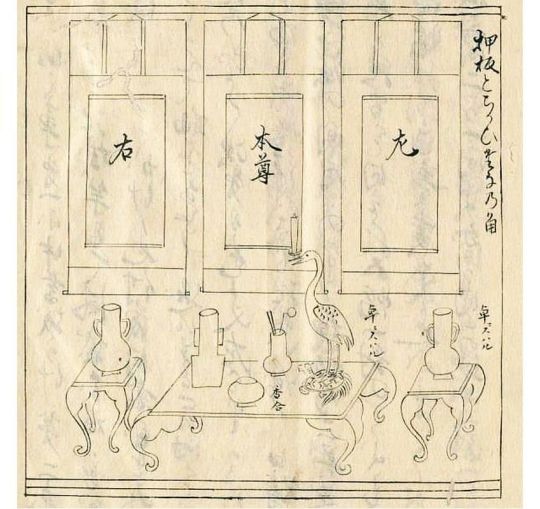
Tanaka adds, however, that this rule is not generally understood by ordinary people.
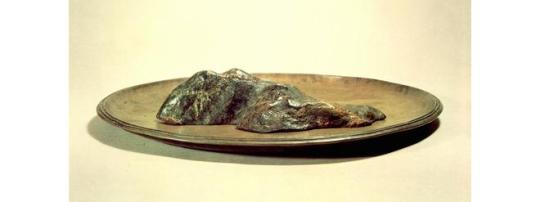
Yoshimasa’s treasured bon-san, known as Zan-setsu [殘雪] (“lingering snow”), resting in the Korean sawari tray that accompanied it from the continent, is shown above -- and it seems that it was this bon-san that established the precedents associated with its use. Even though the tray is empty in the photo, the addition of sand would not raise the height of the stone much, since it would be settled into the sand (rather than sitting on top of it). When placed on the floor of the tokonoma, the bon-san would be low enough that it does not hide part of the scroll, even if the scroll was so long that it nearly touched the floor. This is because the guest’s eyes will always be a certain distance above floor-level, so, as a consequence of the parallax effect, the stone will not hide part of the mounting.
‡One entry in Rikyū’s Nambō-ate no densho [南坊宛の傳書] deals with the way to arrange the bon-san. I will quote the entry in its entirety.
“Concerning the display of a bon-seki [盆石]ᵃ, there are very few people who understand how to do this correctly.
“Now, there is this poem by the Higashiyama-donoᵇ:
‘bon-seki no mae ni ha futatsu hama-bisashi ushiro ni tōki umi sowe naran’
[盆石ノマエニハ弐ツ浜ヒサシ ウシロニ遠キ海ソヱナラン]ᶜ.
“This poem reveals the secret tradition concerning the display of a bon-seki, so you should pay careful attention to every detail that it recounts.
A rough sketch will help [you] remember [the matter].
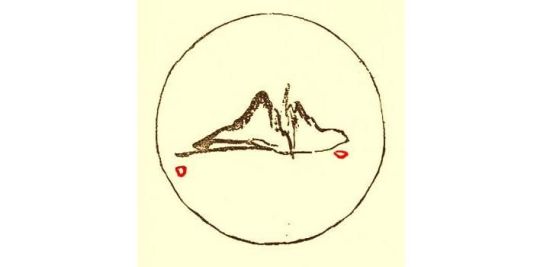
“Depending on the season of the year, the wavesᵈ [behind the stone] should be handled differently. And, of course, the manner of arranging the sand should be appropriate to the scene suggested by the bon-seki’s appearanceᵉ.”
It is precisely because of the parallax effect that the waves are seen on the far side of the stone. ___________ ᵃBon-seki [盆石] (“a stone in a tray”): the word is usually translated “viewing stone” in English. It is another name for the bon-san [盆山] (which literally means “a mountain in a tray”).
ᵇHigashiyama-dono [東山殿] refers to Ashikaga Yoshimasa [足利義政, 1436 ~ 1490]. During his retirement, he was also known as Jisshō-in-dono [慈照院殿].
ᶜ“In front of the bon-seki, two sand-dunes; and behind it, [we] should suggest the far-distant ocean.”
The sand-dunes are low mounds of sand (created by pouring the sand through a paper funnel); the distant ocean is suggested by raking the sand, on the far side of the stone, into the shape of seasonally appropriate waves (the sand-dunes obscure the transition from smooth sand in front to the raked sand behind, which is why they are located near the two ends of the stone). ᵈThe sand in the tray is raked into the shape of waves like the sand in a kare san-sui tei-en [枯山水庭園], using a bamboo skewer.
ᵈIf the stone resembles and island, for example, or a distant mountain, or a plateau, in each case the sand in the foreground, as well as in the background, needs to be treated somewhat differently.
0 notes
Text
you're not the only one, seochang nation we ride at dawn
Am I the only one who ships seobi and the prince. Likke they've been traveling together post plague for seven years. 😉😘
#like...... not saying theyre married but they're married#7 years? 7 years. seven. years.#their dynamic makes me crazy#text
111 notes
·
View notes
Photo
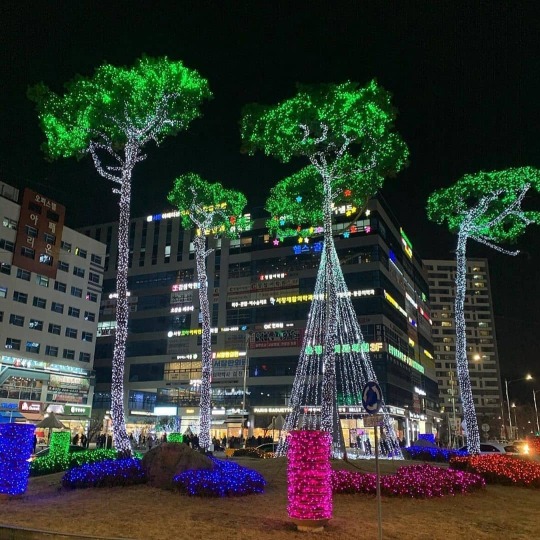
You know its Christmas season when the lights are on everywhere. Last weekend, I attended Seochang's lightening festival. It was so pretty with performances and christmas joy in every corner. Is your neighborhood ready for Christmas? #incheon https://www.instagram.com/p/B52IpmvnImj/?igshid=az1qntmzp579
0 notes





